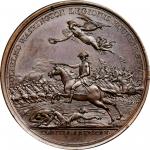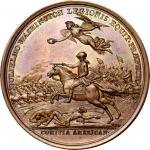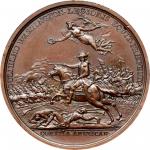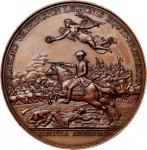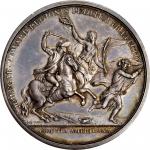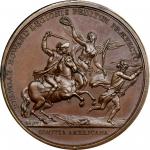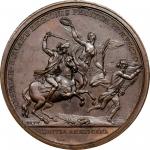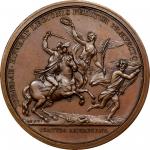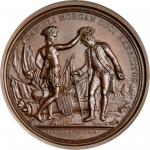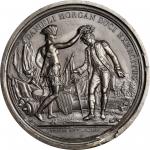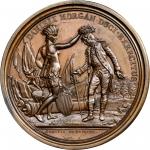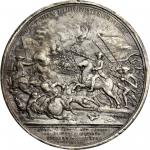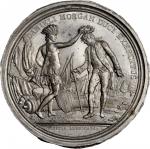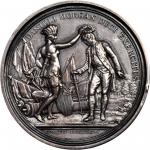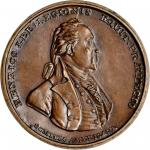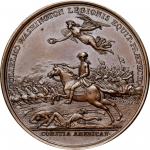1781 William Washington at Cowpens medal. Betts-594. Copper. Original. Paris Mint. 45.8 mm, 615.8 grains. 3.3 - 3.6 mm thick. Choice Mint State.Plain concave edge. An exceptional Paris Mint specimen, showcasing DuViviers designs in spectacularly well detailed form. The surfaces are ideal milk chocolate brown with pale blue and violet across the reflective fields. Only trivial contact marks are seen, along with an inert little speck below IN of WASHINGTON. The wire rim was deftly reduced by filing at the Paris Mint, with vestiges visible on both obverse and reverse. Well struck and choice, just an exceptional piece. The die state is similar to the silver example that precedes this one, Adams state 2, a little later than George Washingtons own in the Massachusetts Historical Society. Adams and Bentley reported 36 specimens in bronze in their census, making this one of the more numerous of the Comitia Americana medals in bronze. Despite this, finding a plain edge original this lovely is no easy task.<p><strong>The Battle of Cowpens</strong><p><strong>The Action:</strong><p>The day after Christmas 1779, Sir Henry Clinton and General Charles Cornwallis left British-occupied New York with more than 8,000 men. Their destination was Charleston, South Carolina, and upon their arrival the focus of the Revolutionary War became the struggle to win the hearts, minds, and battlefields of the Carolinas. Clinton and Cornwallis laid siege to Charleston beginning in April 1780, and the following month they controlled the city. Their army made its way to the middle of South Carolina and encamped near the town of Camden, where Horatio Gates, the newly appointed commander of the Southern Department, encountered Cornwallis force in August 1780. Gates was soundly defeated, his force decimated, his reputation essentially destroyed. Cornwallis and his forces, including reviled Banastre Tarleton, captured the tiny hamlet of Charlotte soon thereafter, then made their way back to winter camp in central South Carolina, in the town of Winnsborough.<p>Following Gates relief from command, General George Washington dispatched a member of his "military family" to the Southern Department: Nathanael Greene. Greenes strategy revolved not around direct large-scale confrontation, but fleeting contact and costly chases, meant to expose the British and their Loyalist partisans to guerrilla attacks and keep their divided forces far from supply lines. The October 1780 American victory at Kings Mountain, along the North Carolina / South Carolina border, bolstered the Patriot cause in the Upcountry. Greene had made his winter camp in Cheraw, in the eastern Pee Dee region of South Carolina, but a portion of his troops under General Daniel Morgan continued to move through the backcountry. Cornwallis dispatched Tarleton to give chase with a force of just over 1,000 men, mostly British regulars.<p>Morgan chose the place he would permit Tarleton to meet his men: at the Cowpens, a pasture near the North Carolina state line close to modern Spartanburg. Morgan, known for his team of crack riflemen, decided to capitalize upon the British stereotype that American militiamen would quickly retreat. He ordered his militia to do just that, then move to the rear, reform, and wait for Continental regulars to break through the British line.<p>Holding the rear high ground, his plan worked like a charm, finished off by an infantry line held together by Col. John Eager Howards leadership and a cavalry charge led by Col. William Washington as the denouement. Morgan described his defeat of Tarleton as "a devil of a whipping." Congress agreed, and selected him to receive a gold medal, while both Howard and Washington were awarded silver medals. Only Cowpens and the 1779 reduction of Stony Point were recognized with three medals. <p>After the victory at Cowpens, Greene and Morgan reunited and moved north, meeting Cornwallis at Guilford Court House in March 1781. With his force badly weakened after the battle, Cornwallis marched for Wilmington, on the North Carolina coast, to regroup. His next, and final, stop would be Yorktown.<p><strong>The Resolution:</strong><p><em>The United States in Congress assembled, considering it as a tribute due to distinguished merit to give a public approbation of the conduct of Brigadier General Morgan, and of the officers and men under his command, on the 17th day of January last; when with eighty cavalry, and two hundred and thirty-seven infantry of the troops of the United States, and five hundred and fifty-three militia from the States of Virginia, North Carolina, South Carolina, and Georgia, he obtained a complete and important victory over a select and well appointed detachment of more than eleven hundred British troops, commanded by Lieutenant Colonel Tarleton; do therefore resolve,</em><p><em>That the thanks of the United States in Congress assembled, be given to Brigadier General Morgan, and the officers and men under his command, for their fortitude and good conduct, displayed in the action at the Cowpens, in the State of South Carolina, on the 17th of January last:</em><p><em>That a Medal of Gold be presented to Brigr Genl Morgan representing on one side the action aforesaid particularising his numbers, the numbers of the enemy, the numbers of killed, wounded and prisoners and his trophies with the inscription patria virtusis [undecipherable], and on the other side his bust with his name and this inscription: Ipse agmen the figure of the General on horseback leading on his troops in pursuit of the flying enemy, with this motto in the Exergue Fortus Fortuna Juvat Virtus Unita Valet.</em><p><p><em>That a medal of gold be presented to Brigadier General Morgan, and a medal of silver to Lieutenant Colonel W. Washington, of the cavalry, and one of silver to Lieutenant Colonel Howard, of the infantry of the United States; severally with emblems and mottos descriptive of the conduct of those officers respectively on that memorable day:</em><p><em>That a sword be presented to Colonel Pickens, of the militia, in testimony of his spirited decisive and magnanimous conduct in the action before mentioned:</em><p><em>Resolved, that a sword be presented to Lieutenant Colonel Howard of the infantry, and one also to Lieutenant Colonel Washington of Recommitted. the Cavalry of the federal army each, that their names may be transmitted honourably to posterity renowned for public virtue and as testimonies of the high sense entertained by Congress of their martial accomplishments.</em><p><em>That Major Edward Giles, aid-de-camp of Brigadier General Morgan, have the brevet commission of a major; and that Baron de Glasbeech, who served with Brigadier General Morgan as a volunteer, have the brevet commission of captain in the army of the United States; in consideration of their merit and services.</em><p><em>Ordered, That the commanding officer in the southern department, communicate these resolutions in general orders.</em><p><em>- Continental Congress Resolution of March 9, 1781</em><p><strong>William Washington at Cowpens</strong><p><strong>The Acquisition:</strong><p>When Thomas Jefferson returned home from Paris in the fall of 1789, he carried 17 medals with him. Eleven of them were silver strikes in a cased set for President George Washington (now the property of the Massachusetts Historical Society via Daniel Webster). Three of the 17 were gold: the Congressionally-awarded medals for General George Washington, General Anthony Wayne, and General Daniel Morgan. The other three were silver, authorized by Congress for presentation to John Stewart (by then deceased) and two heroes of Cowpens: William Washington and John Eager Howard. The last of the medals executed in Paris were all the work of Duvivier, bookending a series that began with Duviviers medal for De Fleury.<p>The medal for William Washington lacks the paper trail that benefits so many of the others, but it was created in 1789 contemporary to Dupres work on the Morgan and Jones medals. It is unknown which of the Cowpens medals (Washington or Howard) Duvivier completed first.<p><strong>The Presentation:</strong><p>Like the other heroes of Cowpens (and those of Stony Point), William Washington received his medal from President George Washington via a letter dated March 25, 1790. No copy of that letter is known to have survived. William Washington apparently didnt have the letter and medal in hand until significantly later, as his thank you reply wasnt sent until November 7: "Your Excellencys favor of March 25th accompanied with a Medal struck by order of the late Congress I have receivd. This flattering mark of respect conferd on me by the Representatives of my Country will make an indelible impression of Gratitude on my Mind."<p><strong>Obverse: </strong>Lt. Col. Washington, mounted and gesturing forward with his sword, stands apart from the body of his troops but moves right to left before them. Two British soldiers lie dead before him. The main body of Washingtons cavalry is seen at right, putting British cavalry to the chase at left. A Fame flies above Washington, carrying a palm of Victory and a laurel wreath. The legend GULIELMO WASHINGTON LEGIONIS EQUIT. PRAEFECTO means "William Washington, commander of the cavalry regiment." COMITIA AMERICANA appears in the exergue below. The original Congressional resolution called for the obverse to display "the charge made by him on the enemys Cavalry, they wheeling, he charging; under his party the figures 80 under the enemy 250, with this Motto- Virtute non Numeris valet." While the legend was not retained, the general concept was.<p><strong>Reverse:</strong> An unending wreath of laurel, festooned with internal ribbons at top and bottom, surrounds a seven-line legend: QUOD PARVA MILITUM MANU STRENUE PROSECUTUS HOSTES VIRTUTIS INGENITAE PRAECLARUM SPECIMEN DEDIT IN PUGNA AD COWPENS XVII JAN. MDCCLXXXI. The legend is translated by Loubat as "Because, in vigorously pursuing the enemy with a handful of soldiers, he gave a noble example of innate courage at the Battle of Cowpens, January 17, 1781." The original Cowpens resolution requested a reverse inscription reading "In honor of the gallant behaviour of Lt Col Wm Washington in the Action of 17th January 1781." The inscription, as written, came from Frances Academy of Inscriptions and Belles-Lettres, retaining much of the sense but none of the verbiage of the original resolution.<p><p><p>From the John W. Adams Collection. Acquired from Coin Galleries’ sale of July 1991, lot 3936.

